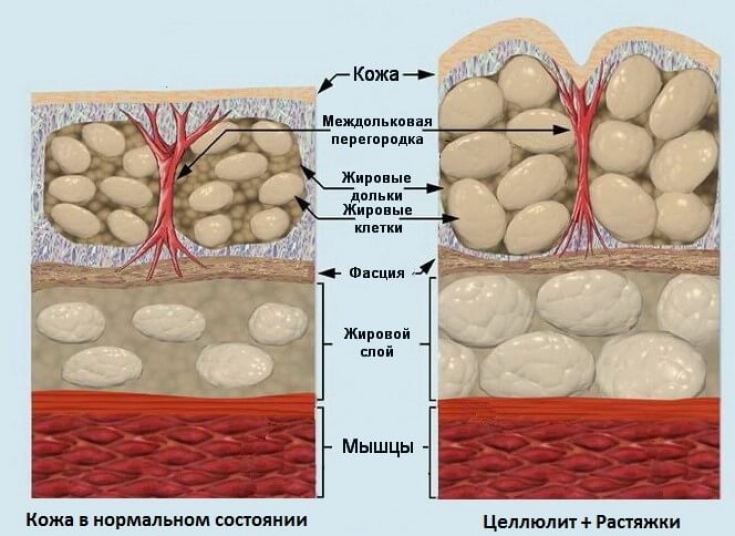About 70% of women worldwide are estimated to suffer from stretch marks or striae.
Stretch marks are caused by abnormal and excessive stretching of the skin. Many perceive them as normal changes that are the result of childbirth, aging or overweight.
However, for some people, striae can be a serious aesthetic problem. They can also significantly affect a person's mental health and quality of life, including loss of self-confidence, lower self-esteem, and difficulties in sexual relationships.
On estet-portal.com read why stretch marks occur and how to get rid of stretch marks on the body.
Who gets striae on body
Studies have shown that the buttocks are the most common location for stretch marks in women, with 86% of the fair sex experiencing them at least once in their lives.
Abdomen is the next most common area of the body where stretch marks appear (in 48% of women), followed by hips (46%).
Studies also show that 85% of men have stretch marks on the buttocks, 28% on the lower back and 25% on the knees.
There are two main types of stretch marks:
- Striae rubra characterized by early onset, immature grooves, with inflammatory, erythematous changes;
- Striae alba is a term used to describe a more chronic and permanent form of stretch marks. They are the result of the gradual transformation of Striae rubra.
How to beat stretch marks on the skin: cosmetic possibilities of the redermalization procedure
In appearance, these are characteristically pale, atrophic, avascular lesions, outwardly similar to stretched, maturescar tissue.
Why do stretch marks appear on the skin
The pathogenesis of stretch marks remains unclear and there are many histopathological theories. They are based on the understanding that the fundamental trigger for the formation of stretch marks is based on the breakdown of the collagen matrix.
The underlying histology of stretch marks is similar to the histology of scars on the skin after injury. For example, there will be signs of early inflammatory changes followed by thinning or thickening of the skin.
Microscopic analysis of striae shows a violation of the structure of the skin fibers and a change in the mechanical function of the dermis.
These changes can be caused by remodeling forces acting on the skin, most often as a result of factors such as:
- fat tissue expansion;
- increased intra-abdominal pressure.

Common risk factors for developing stretch marks are thought to be related to:
- family history;
- fast growth spurt;
- pregnancy;
- obese;
- Cushing's syndrome (metabolic disorder);
- Marfan's syndrome (a genetic disorder affecting connective tissueb).
How to remove stretch marks on the body
Various topical treatments in the form of creams can be used to eliminate stretch marks on the body, however, only some of them have proven effectiveness.
Read the most interesting articles in Telegram!
Vitamin A analogue tretinoin, which is well known for its benefits in reducing the appearance of facial wrinkles, photodamage and aging, has been used with some success for stretch marks.
To date, there is little evidence to support the effectiveness of any preventive measures for the development of stretch marks.
1. Laser is a popular and effective option for many aesthetic skin and dermatological conditions and appears to hold promise for both striae rubra and striae alba.
Lasers are most effective for treating stretch marks as they target the hemoglobin chromophore which is present in dilated blood vessels striae rubra.
Laser treatment of stretch marks results in damage to the epithelium, followed by re-epithelialization and stimulation of extracellular collagen synthesis, and increases elastin production.
Lasers targeting the water chromophore in the skin, such as the 10600nm CO2 ablative laser and the 2940nm Er:YAG laser, are widely used to treat acne scars.
These lasers are also used to treat stretch marks, especially striae alba, which have similar histological features to acne scar tissue.
2. Microdermabrasion has also been shown to induce re-epithelialization and stimulate collagen synthesis. These changes are important to reduce the appearance of cicatricial changes. However, there is very little evidence that microdermabrasion is effective in treating stretch marks.
3. Chemical peels are not enough to treat stretch marks, despite the potential for collagen stimulation, skin regeneration and remodeling. The elimination of stretch marks using peels in combination with other methods is more optimistic.
4. There is only one published study on the use of microneedling for stretch marks, and the results are encouraging.
5. Some studies have examined the benefit of radiofrequency therapy for stretch marks and reported improvement in the appearance of stretch marks after treatment in most cases.
6. PRP modulates cell proliferation, angiogenesis and inflammatory responses, with stimulation of tissue regeneration.
There are very few peer-reviewed publications on the use of PRP specifically for the treatment of stretch marks, and they state that there is a modest improvement in the appearance of striae alba and rubra. However, these studies were based on subjective assessments of physician and patient and have limited evidentiary value.
There are many treatment options available for stretch marks. However, reliable data on the effectiveness of treatment is limited, and therefore the choice of the best method of therapy remains difficult.
However, ablative and non-ablative fractional lasers as well as Nd:YAG lasers may be the most effective non-surgical treatments for stretch marks.
Research results using topical tretinoin cream are also encouraging.
Combination therapies such as PRP with RF, microneedling and microdermabrasion appear promising.
Stretch marks on the skin: practical experience in the treatment of a defect at its various stages







Add a comment